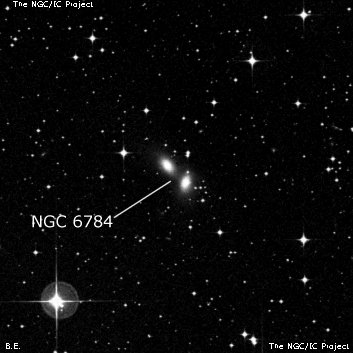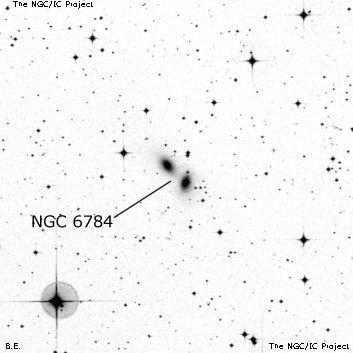NGC/IC Project Restoration Effort
(This is a very very beta version)
NGC6784


Basic Information
Location and Magnitude
Right Ascension: 19:26:31.2
Declination: -65:37:36
Constellation: PAV
Visual Magnitude: 13.8
Historic Information
Discoverer: Herschel J.
Year of discovery: 1835
Discovery aperture: 18.3
Observational
Summary description: eeeF, pS, am S st
Sub-type: E-S0
Corwin's Notes
=====
NGC 6784. There are two galaxies of virtually equal magnitude and diameter
here, separated by 4.6 seconds of time, and 30 arcsec -- the orientation is
southwest-northeast. The northeastern one is slightly brighter at V = 13.62
-- the southwestern is V = 13.80 -- and slightly larger at D_25 = 58 arcsec --
the southwestern is D_25 = 50 arcsec. The mean surface brightness of the
brighter galaxy, however, is slightly lower at 13.29 Vmag/arcmin^2, while that
for the fainter galaxy is 13.14. Which one did JH see?
He has three observations of his nebula and records it as "eeF" all three
times. He made only two firm measurements of its position, however (about the
third, he says, "No RA observed, and the PD not to be put in competition with
those of regular observations."). These are separated by 8.2 seconds and 68
arcseconds, within his usual error bars for repeated measurements of the same
object. Also his positions are oriented nw-se, while the galaxies are sw-ne
on the sky. So, the positions don't help us decide.
Falling back on the photometry, I'm going to take the brighter galaxy as JH's
nebula. If he saw the fainter one, its slightly higher surface brightness may
have given it the appearance of a faint star.
But I have to stress that the galaxies are so similar that we really can't say
for sure which one JH saw. The colons reflect that.
Steve's Notes
=====
NGC 6784
30" (10/12/15 - OzSky): at 303x; NGC 6784 is a close pair of similar galaxies oriented SW-NE that were both easily visible. NGC 6784A, the southwest component, appeared fairly faint, small, slightly elongated, 24"x20". A mag 15 star is 0.7' SW of center and a ~4" pair of mag 15/15.5 stars is 0.8' N. NGC 6784B, the northeast component, is slightly brighter and logged as fairly faint to moderately bright, small, slightly elongated SSW-NNE, 24"x 18", slightly brighter nucleus. The pair is situated 5' NW of mag 8.3 HD 181957 and 20' ESE of mag 7.3 HD 181018.



